Friday, January 16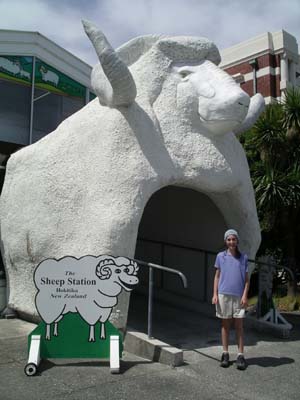
Paula: After one final view of the wonderful mountains and a stop by the lamb paddock, we left Arthur's Pass and headed for the West Coast! The 370 kilometer drive to Lake Moeraki in Southwest New Zealand took us a good part of the day as we included several stops along the way.
The initial drive through Arthur's Pass was dramatic. The windy pass cuts right through the Southern Alps with a number of impressive viewpoints and waterfalls sometimes cascading right over the highway. After a couple of hours we began to notice a change in the vegetation with giant ferns becoming the dominant plant. Soon after, we spotted the Tasman Sea. The waves along the coast were impressive and we soon learned that the ocean on the southwest coast is usually not safe for swimming because of the sudden drop-off, undertow and sharks. We were content to stop in Hokitika and observe this body of water which separates New Zealand from Australia. It was here that we managed to purchase four inexpensive fishing rods in preparation for our stay on Lake Moeraki. Katie also purchased some yarn made from Merino wool which she plans to use on a new knitting project. Hokitika had a cowboy feel and used to be a gold mining town.
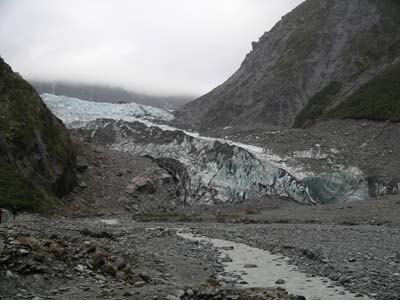 After
hitting the coast, we then began our trip south to the Franz Josef and Fox
Glaciers. It was interesting to note that sheep, cattle and deer farms continued
to dot the roadside and these pastures often went all the way to the coastline.
There is only one road along the west coast - it is sparsely traveled and
almost all of the numerous bridges have only one lane! There were only a few
small towns along the way. Built up along the roadway, each had small tidy
ranch homes, a school and rugby field. As we drove into Franz Josef were almost
surprised to discover other tourists and several thriving
After
hitting the coast, we then began our trip south to the Franz Josef and Fox
Glaciers. It was interesting to note that sheep, cattle and deer farms continued
to dot the roadside and these pastures often went all the way to the coastline.
There is only one road along the west coast - it is sparsely traveled and
almost all of the numerous bridges have only one lane! There were only a few
small towns along the way. Built up along the roadway, each had small tidy
ranch homes, a school and rugby field. As we drove into Franz Josef were almost
surprised to discover other tourists and several thriving 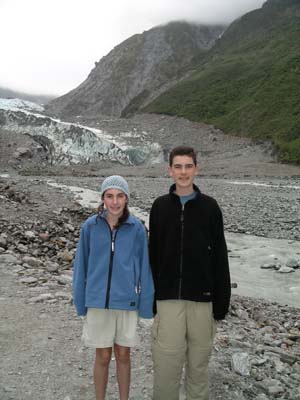 commercial
businesses. The glacier and hiking here is the main attraction and the businesses
cater to the outdoor tourists. Helicopters seemed to be one of the more popular
ways to view the glacier and we later learned that the copters are really
a part of life in the area which is really quite remote. Even our lodge has
a helicopter landing pad because the closest hospital requires an over 4 hour
drive. We decided to view this glacier from a distance and walk up to Fox
Glacier which was another 30 minutes away.
commercial
businesses. The glacier and hiking here is the main attraction and the businesses
cater to the outdoor tourists. Helicopters seemed to be one of the more popular
ways to view the glacier and we later learned that the copters are really
a part of life in the area which is really quite remote. Even our lodge has
a helicopter landing pad because the closest hospital requires an over 4 hour
drive. We decided to view this glacier from a distance and walk up to Fox
Glacier which was another 30 minutes away.
Fox Glacier was striking. As we walked up the valley and river bed to the base of the glacier, the work of this massive moving ice was obvious. We could clearly see how the valley has been literally cut over the last century. Though retreating most of the last hundred years, this glacier actually advanced 1 km in the past 10 years but is now again on the retreat.
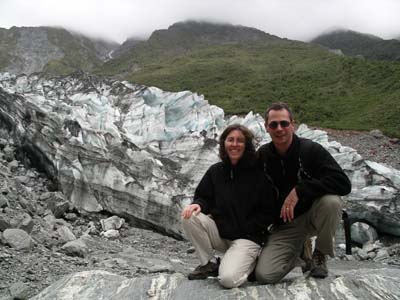 We
finally pulled into the Lake Moeraki Wilderness Lodge just ahead of dinner.
The lodge sits on a small river just south of the lake. The Southern Alps
reflect off this peaceful lake. The small lodge is the only development in
the area and uses its own hydro-generator to supply power. At dinner we meet
many of the same nice people we had met at the Arthur's Pass Lodge. Many guests
visit both of Gerry's lodges and we enjoyed hearing how they had spent their
days and advice on how we should spend our days here.
We
finally pulled into the Lake Moeraki Wilderness Lodge just ahead of dinner.
The lodge sits on a small river just south of the lake. The Southern Alps
reflect off this peaceful lake. The small lodge is the only development in
the area and uses its own hydro-generator to supply power. At dinner we meet
many of the same nice people we had met at the Arthur's Pass Lodge. Many guests
visit both of Gerry's lodges and we enjoyed hearing how they had spent their
days and advice on how we should spend our days here. 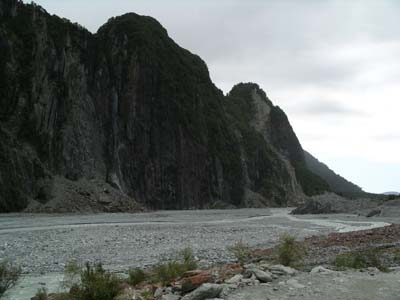
Before retiring, we enjoyed a night walk with one of the guides to view the stars in the Southern Hemisphere and see glow worms in the rainforest. We were able to view the Southern Cross, a constellation not visible from North America. This constellation is used for navigating as we might use the Big Dipper and North Star. The clear night made it possible to easily spot Mars, Venus, Orion's Belt and the Seven Sisters. The glow worms were interesting and looked like Christmas tree lights in the dense forest. These larva glow at night and create hammock-like webs to catch insects. We read that the larvas that glow the brightest are the most hungry!
Tomorrow is supposed to be a beautiful day, and we plan to spend much of it kayaking and fishing on Lake Moeraki.
Katie's Kwick Kwacks: Our Evening Walk - Glow Worms and Stars. On our
evening walk we learned many interesting facts about stars in the Southern
Hemisphere and the glow worms that we saw lit up in dark corners of bushes.
During our journey, we learned some interesting facts about a constellation
only seen here in the Southern Hemisphere - the Southern Cross. This unique
constellation is the equivalent to the Northern Hemisphere's "Big Dipper."
It is formed by four stars which form a diamond shape, and when connected
reveal a perfect cross. Beside the cross are two stars known as the "Pointer
Stars." They are the equivalent of the Northern Hemisphere's "North
Star." People in the Southern Hemisphere use these two stars to guide
them just like people in the United States use their hemispheres' one shiny
star to lead the way.
We also learned a lot about "glow worms" as we saw them on our
walk. Glow worms are tiny worms that live on hill sides in the rainforest.
They live in places that get very little light during the day and in spots
protected by plants. They live in a larva form for 6-9 months and grow to
be about a half inch long. After they emerge from their larva state they are
in the form of a gnat, but only live long enough to reproduce - about two
days. While in the larva form, they light up to attract insects. When the
insects come to the light they get caught in the glow worm's web and become
dinner. We also learned that the larvas that light up the brightest are the
hungriest. As you can see, we learned a lot of interesting facts on our walk
and continue to become more and more fascinated by the wonderful environment
of New Zealand.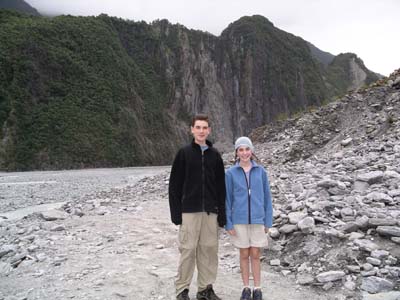
David's Daily Dump: Glaciers. Today as we were driving to Lake Moeraki, we stopped at the magnificent Fox glacier. We took a hike up through the valley which the glacier had carved over the course of many thousand years. Fox glacier formed thousands of years ago, when snow on the mountains slowly compressed under the weight of increasing snow fall, creating a solid layer of thick ice. This ice steadily builds up and pushes through the mountains, carving many present-day valleys. Depending on how much snow fall there is in a certain period of time, the glacier either retreats or advances. If there is not enough snow to replace the melting ice, the glacier retreats, which is what it has been doing for the last several years. If there is a surplus of snow replacing the melting ice, then the glacier advances. When Fox is advancing, it has been proven that the glacier can slide down the mountains up to 5 meters a day. As we walked to the gargantuan glacier, we saw a small mountain peak called "cone rock," which is hundreds of feet higher than the valley floor. We were told that in the 1700's, the glacier had advanced way past cone rock, and had been just as high as it. The present glacier is at least half a mile away from cone rock, and a quarter the height of it. I greatly enjoyed visiting Fox Glacier and learning about its story.
